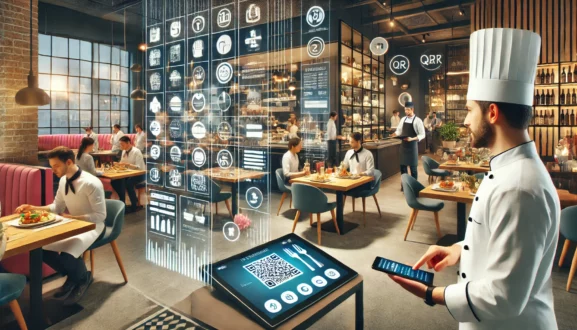17 Essential Restaurant Review Websites: Navigating the Digital Dining Scene
In a world where your next meal is just a click away, restaurant review websites have become the digital age’s palate guide.
These platforms don’t just influence where people decide to eat; they shape the very landscape of the restaurant industry.
So, if you’re on the fence about diving into the world of online reviews or if you’ve been neglecting your digital presence, it’s time to reconsider. Here’s why these sites are a must for your eatery, along with a spotlight on 17 key players in the space.
Keeping Your Info Up-to-Date
Got a new menu? Changed your opening hours? Make sure this info is current across all platforms. There’s nothing more frustrating for a potential customer than showing up for a taco Tuesday special on a Wednesday because your Google My Business profile wasn’t updated.
Responding to Reviews
Whether it’s a raving review or a not-so-glowing critique, responding to feedback shows that you value customer input and are committed to improving. Plus, it’s your chance to showcase your restaurant’s personality.
Encouraging More Reviews
Actively inviting customers to leave reviews can boost your numbers and, in turn, your visibility. Think about it: more reviews = more data for those SEO algorithms to munch on. Make reviews part of your restaurant KPIs to make sure they get the attention they deserve.
17 Must-Know Restaurant Review Websites
1. Google My Business
Google My Business (GMB) is paramount for any restaurant aiming to boost its online visibility. By allowing your restaurant to appear in local search results and on Google Maps, GMB makes it easier for customers to find you. Listings include essential information like your address, phone number, business hours, and customer reviews. High-quality photos and timely responses to reviews, both positive and negative, can significantly enhance your GMB profile.
Creating a GMB account is straightforward. Once verified, you can manage your information, interact with customers, and view insights on how people find your business online. Regularly updating your listing, including special hours for holidays and responding to Q&As, keeps potential customers well-informed.
2. Facebook
Facebook offers a broad platform for restaurants to reach potential customers. Beyond just reviews, your Facebook Business Page can host a wealth of information, including menus, upcoming events, and photos of your dishes. Engagement on Facebook goes beyond simple reviews; it includes likes, shares, and comments, offering a dynamic interaction with your customer base.
To optimize your Facebook presence, regularly post engaging content, respond to messages promptly, and encourage satisfied customers to leave reviews. Utilizing Facebook Ads can also target specific demographics, helping to increase your restaurant’s visibility among potential customers.
3. Yelp
Yelp is renowned for its influence on consumer decisions. With a strong emphasis on user-generated content, Yelp provides a platform for detailed reviews and ratings. Restaurants can manage their Yelp listing by claiming their business and filling out their profile with comprehensive information, including photos, menus, and hours.
Engagement is key on Yelp. Responding to reviews, both positive and negative, demonstrates your commitment to customer service. Yelp also offers advertising options to increase your visibility on the platform, potentially driving more business to your restaurant.
4. TripAdvisor
TripAdvisor extends beyond just restaurant reviews, catering to travelers looking for a complete dining experience. It ranks businesses based on the quantity and quality of reviews, making it essential for restaurants to encourage happy customers to leave feedback. Listing your restaurant involves creating a detailed profile, including accurate information, photos, and responding to reviews to engage with your audience.
TripAdvisor’s tools for businesses also allow for tracking the performance of your listing and understanding customer demographics. This insight can help tailor your marketing and operational efforts to better serve your target audience.
5. Zomato
Zomato operates globally, providing a comprehensive platform for restaurant discovery, reviews, and even food delivery in some areas. Restaurants can claim their listing on Zomato to update their details, post photos, and interact with reviews. Being active on Zomato can help attract a diverse clientele, especially in markets where the platform has a strong presence.
Promotions and sponsored listings are available to increase your restaurant’s visibility on Zomato. Engaging with customer feedback and maintaining an up-to-date menu and hours are crucial for success on the platform.
6. OpenTable
OpenTable is not just for making reservations; it’s also a platform where customers can leave reviews after dining. This service combines convenience with customer feedback, offering a unique opportunity for restaurants to attract bookings and simultaneously gather reviews. By partnering with OpenTable, restaurants can manage reservations, streamline their operations, and enhance their online presence through customer feedback. Engaging with this feedback and maintaining high service standards can improve your rating on the platform, attracting more customers.
7. Zagat
Zagat has a long-standing reputation for providing curated restaurant reviews and ratings. Known for its concise, quote-based reviews and numerical ratings, Zagat guides diners to the best places to eat in cities around the world. For restaurateurs, a high Zagat rating can be a badge of honor, signaling quality and consistency to potential customers. Participation and recognition on Zagat can significantly elevate a restaurant’s prestige within the culinary community and among diners.
8. The Infatuation
The Infatuation offers a fresh, millennial-focused perspective on dining and restaurants. With its in-depth reviews and popular #EEEEEATS hashtag, The Infatuation has carved out a niche among younger foodies looking for authentic dining experiences. For restaurants, being featured or reviewed positively can lead to increased interest from a vibrant, engaged audience. The platform’s emphasis on social media and user-generated content also offers opportunities for restaurants to showcase their offerings in a dynamic, visually appealing way.
9. Michelin Guide
Michelin Guide is synonymous with culinary excellence. Earning a Michelin star can transform a restaurant, signifying it as one of the best in the world. While the criteria for selection are rigorous, featuring in the Michelin Guide is a goal for many chefs and restaurateurs. The guide focuses on the quality of the ingredients, mastery of flavor and cooking techniques, the personality of the chef in their cuisine, value for money, and consistency between visits.
10. Eater
Eater is both a food news and review platform that focuses on the latest trends, restaurant openings, and culinary events. Being featured on Eater can significantly raise a restaurant’s profile, especially among food enthusiasts who follow the latest dining trends. The platform’s comprehensive city guides also help locals and tourists alike discover the best places to eat in their area.
11. HappyCow
HappyCow is a niche platform catering specifically to vegetarians, vegans, and those looking for plant-based dining options. It’s an invaluable resource for restaurants that offer these dietary options to gain visibility among a growing segment of the population interested in sustainable and ethical eating. Listing on HappyCow can attract both locals and travelers seeking plant-based dining experiences.
12. TheFork
TheFork, a TripAdvisor company, combines restaurant reviews with a reservation system, making it a one-stop-shop for discovering and booking dining experiences. Popular in Europe, TheFork offers special discounts and loyalty programs, incentivizing users to book through the platform. For restaurants, participating in TheFork’s programs can increase visibility and bookings, while the review component helps build reputation and trust among potential customers.
13. Gayot
Gayot offers professional, expert-driven restaurant reviews, using a unique 20-point scale to evaluate dining establishments. Named after its founder, André Gayot, who helped develop the concept of the modern restaurant guide, Gayot’s reviews are respected for their thoroughness and reliability. For restaurants, a high rating on Gayot can signify quality and excellence, appealing to discerning diners.
14. AllergyEats
AllergyEats is a niche platform focused on helping diners with food allergies find safe places to eat. It’s an essential resource for restaurants that offer allergy-friendly menus or accommodations, allowing them to connect with a specific and highly engaged audience. Participating in AllergyEats can demonstrate a restaurant’s commitment to inclusivity and safety in dining.
15. Yell
Yell, the digital successor to the Yellow Pages in the UK, provides a broad directory of businesses, including restaurants. With features for reviews and ratings, Yell helps locals discover dining options in their area. For restaurants, maintaining a presence on Yell is an essential part of local SEO strategy, ensuring they appear in searches by potential customers nearby.
16. UpMenu
UpMenu is an innovative platform that combines a restaurant’s website builder with an online ordering system and a review aggregator. It enables restaurants to directly collect customer feedback, manage their online presence, and streamline orders in one place. Integrating UpMenu into a restaurant’s operations can enhance customer satisfaction by making it easier to leave feedback and order online.
17. Foursquare
Foursquare has evolved from a location-based social networking site into a valuable tool for discovering local businesses, including restaurants. Users can leave tips and reviews, making it a useful resource for others looking to find the best dining spots. For restaurants, maintaining an up-to-date Foursquare profile can help attract local foot traffic and enhance their digital word-of-mouth.
Restaurant review websites are the New Word-of-Mouth
Remember when you’d rely on a recommendation from a friend? Well, restaurant review sites are like having thousands of friends whispering their dining secrets in your ear, except these friends are also strangers with very strong opinions about food.
SEO Magic
Being active and having positive reviews on these sites can do wonders for your restaurant’s online visibility. It’s like sending out a beacon on the internet saying, “Hey, we’re here, and we’re delicious!”
Customer Trust
When you see a place with loads of positive reviews, it’s like a green light for your taste buds. People trust what others have to say about their dining experiences, making these reviews a goldmine for building customer trust before they even step foot in your restaurant.
Improving Your Restaurant Review Website Listings
To maximize the impact of your presence on these restaurant review websites, consider the following strategies:
Complete and update your profiles: Ensure that your listings are complete with up-to-date information, including your business hours, menu, location, and photos. High-quality, appealing images of your dishes and interior can make a significant difference.
– Engage with reviews: Respond to reviews in a timely and professional manner, thanking customers for positive feedback and addressing any criticisms constructively. This shows potential customers that you value feedback and are committed to improvement.
– Encourage reviews: Prompt happy customers to leave reviews. This can be done through subtle reminders at the end of their meal, via follow-up emails, or through social media prompts.
– Use special features: Many review platforms offer booking integrations, special promotion options, and advertising opportunities. Utilize these features to enhance visibility and attract more customers.
– Monitor your performance: Regularly check your reviews and ratings across platforms to understand customer perceptions and identify areas for improvement. Many sites offer analytics tools to help track your performance over time.
By implementing these strategies, restaurants can significantly enhance their online presence, attract more customers, and build a strong reputation in the competitive dining industry. In the next part, we’ll continue with detailed overviews of the remaining restaurant review platforms.



Pingback: Social Media Marketing for Restaurants: A Complete Guide
Pingback: How to grow your restaurant reviews on sites that matter - Restaurant Insider